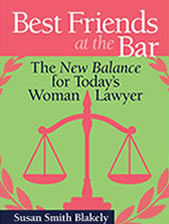Sometimes you just have to learn what you would rather not know. Here is a case in point.
Gender bias is a terrible and destructive thing. We all seem to understand express and intentional bias, and there are laws to protect us against it in the workplace. That is the easiest kind of bias to spot. It is obvious when someone tells you that you cannot have the case because you are a woman or when someone targets you with a gender slur.
However, it is more complicated with implicit gender bias, which can be subtle and unintentional but also can be just as destructive to a career. To learn more about implicit bias and how to spot it and eliminate it, read the new book, Breaking Through Bias: Communication Techniques for Women to Succeed at Work (Bibliomotion, 2016), released last week. Written by my friend Andrea Kramer, a partner at McDermott Will in Chicago, and her husband Al Harris, a law firm founder, it is a virtual primer on bias in the workplace and how to overcome it. Andie and Al have been studying these issues for years in their efforts to improve advancement of women lawyers in law firms. Now, they are making all of their research and findings available to you as a super assist in advancing your talents and your careers.
For more on this subject, you also should look at my book, Best Friends at the Bar: Top-Down Leadership for Women Lawyers (Wolters Kluwer/Aspen 2015). The topic of unconscious bias (another name for implicit bias) is discussed in Chapter One of that book because it is so critical to the discussion of retaining and advancing women lawyers. I include fabulous advice from the legendary lawyer Mary Cranston of Pillsbury Winthrop Shaw Pittman on achieving gender diversity and combating gender bias in law firms. Here is a summary:
- Push from the top. There must be leadership from the top not just lip service. The leaders must understand unconscious bias. An example is identifying women as having less potential for leadership and stereotyping them as having no “bandwidth”;
- Put women in top jobs and let them prove themselves. Give them a chance to succeed instead of making unfounded assumptions; and
- Give women gender training so that they are more proficient in recognizing and controlling gender stereotyping. Women must have this information so that they do not play into the gender stereotypes.
I might also add the obvious — that the male lawyers need that same gender training! There is plenty on that in the book as well.
So, join Andie and Al and me in our pursuit to make the law a better and more rewarding profession for women. As they say in their promotional materials, the cost of a book is less than the cost of lunch.
Skip lunch one day, if that is what it takes, and protect your future!












